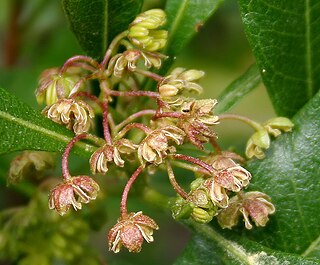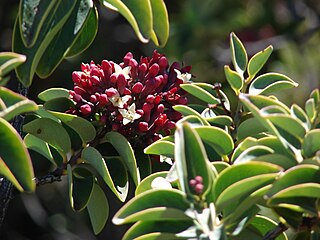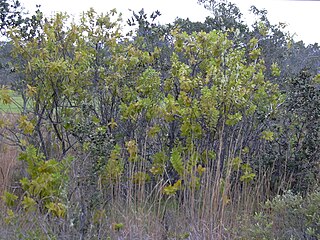
The Auwahi Dryland Forest Restoration Project has produced a substantial forest on the southwestern slopes of Haleakala on the island of Maui. The mostly volunteer-based restoration focuses on the 4,000-foot elevation range. [1]

The Auwahi Dryland Forest Restoration Project has produced a substantial forest on the southwestern slopes of Haleakala on the island of Maui. The mostly volunteer-based restoration focuses on the 4,000-foot elevation range. [1]
Pre-contact dryland forest ecosystems were reduced to less than five percent of their original range by clearing, grazing and invasive species in the late 1800s. The wood went to fuel the boilers at sugarcane mills and to make charcoal. By the early 1900s, the land was almost totally bereft of `ohi`a and koa trees. Kikuyu grass was imported in the 1940s and became pervasive. [1]
Restoration was initiated in 1997 by fencing a 10-acre area of Ulupalakua Ranch, using U.S. Fish and Wildlife Service funds. It was led by retired United States Geological Survey biologist Art Medeiros. [2]
In June 2003, the Leeward Haleakala Watershed Restoration Partnership was formed and supported the project. The partnership brought eight large landowners (holding 43,715 acres) together to better manage the watershed on Haleakala's southwestern rift zone. [1]
In 2012, native cover increased from 3 percent to 82 percent by 2012 within the project area. [2] 14 of 22 native tree species and six of seven native shrub species had successfully reproduced in restoration plots. 99% were native 'o'hia, Coprosma foliosa, Osteomeles anthyllidifolia, Chamaesyce celastoides, Nestegis sandwicensis and nonnative Bocconia frutescens . Stem counts had increased from 12.4 to 135.0/100 m2, and native species diversity increased from 2.4 to 6.6/100 m2. Reproducing species included two types of sandalwood – iliahi and iliahialoe. [3] Mauila and hao (also the word for iron in the Hawaiian language) were present. [2]
More than 50 native species are found in the Auwahi region, including six endangered and five of concern. [1]
Native tree species are susceptible to Fusarium oxysporum , a vascular wilt fungus that is fatal to trees of all sizes. [1]
Goals include: [1]
Reforestation areas are fenced, and feral pigs, goats and axis deer are removed to prevent them from eating saplings and destroying habitat. Next, herbicide is applied to remove invasive plant species. Then 'a'ali'i are planted to prevent invasives from reclaiming the area. After the 'a'ali'i have grown to height of six or more feet, other native tree sapling are planted. [2]
The project organizes monthly site visits carrying 20 to 30 volunteers. Volunteers plant saplings, gather seeds and pull weeds. [2]

Acacia koa, commonly known as koa, is a species of flowering tree in the family Fabaceae. It is endemic to the Hawaiian Islands, where it is the second most common tree. The highest populations are on Hawaiʻi, Maui and Oʻahu.

Haleakalā National Park is an American national park located on the island of Maui in the state of Hawaii. Named after Haleakalā, a dormant volcano within its boundaries, the park covers an area of 33,265 acres, of which 24,719 acres is a wilderness area. The land was designated a national park in 1976 and its boundaries expanded in 2005.

Dodonaea viscosa, also known as the broadleaf hopbush, is a species of flowering plant in the Dodonaea (hopbush) genus that has a cosmopolitan distribution in tropical, subtropical and warm temperate regions of Africa, the Americas, southern Asia and Australasia. Dodonaea is part of Sapindaceae, the soapberry family.

Charpentiera is a flowering plant genus in the family Amaranthaceae. It consists of five species endemic to Hawaiʻi, where they are known as pāpala, and one species found only on the island of Tubuai in the Austral Islands. All species are trees, some reaching more than 10 metres (33 ft) in height. The genus is named for Arsène Charpentier (1781-1818), professor of pharmacy at Antwerp from 1810 to 1814 and at Cherbourg from 1814 to 1816.

Metrosideros polymorpha, the ʻōhiʻa lehua, is a species of flowering evergreen tree in the myrtle family, Myrtaceae, that is endemic to the six largest islands of Hawaiʻi. It is a member of the diverse Metrosideros genus, which are widespread over the southwest Pacific. It is the state tree of Hawai‘i.

Acacia koaia, known as koaiʻa or koaiʻe in Hawaiian, is a species of acacia that is endemic to Hawaii. It is closely related to koa, and is sometimes considered to be the same species.

Hosmer's Grove is an example of experimental forestation from Hawaii's territorial days. Located just inside Haleakala National Park near the summit of Haleakala in Maui, Hawaii, it includes a campsite and several hiking trails. The grove is well known amongst birdwatchers due to the abundance of endemic honeycreepers at the site, including Iiwi, Apapane, Hawaii Amakihi, and the Maui Alauahio.

Mezoneuron kauaiense is a rare shrub or small tree in the genus Mezoneuron, that is endemic to Hawaii. Common names include uhiuhi, kāwaʻu (Maui), and kea (Maui). It is threatened by invasive species, particularly feral ungulates.

The ʻākohekohe, or crested honeycreeper, is a species of Hawaiian honeycreeper. It is endemic to the island of Maui in Hawaiʻi. The ʻākohekohe is susceptible to mosquito‐transmitted avian malaria and only breeds in high‐elevation wet forests.

The Maui parrotbill or kiwikiu is a species of Hawaiian honeycreeper endemic to the island of Maui in Hawaii. It can only be found in 50 square kilometres (19 sq mi) of mesic and wet forests at 1,200–2,150 metres (3,940–7,050 ft) on the windward slopes of Haleakalā. This species is critically endangered, with an estimated population in 2016 of 250-540 individuals, but more recent estimates of less than 150 individuals. Fossil evidence indicates that the bird could at one time be seen in dry forests at elevations as low as 200–300 metres (660–980 ft), as well as on the island of Molokaʻi.

Flueggea neowawraea, the mēhamehame, is a species of flowering tree in the family Phyllanthaceae, that is endemic to Hawaii. It can be found in dry, coastal mesic, and mixed mesic forests at elevations of 250 to 1,000 m. Associated plants include kukui, hame, ʻahakea, alaheʻe, olopua, hao, and aʻiaʻi. Mēhamehame was one of the largest trees in Hawaiʻi, reaching a height of 30 m (98 ft) and trunk diameter of 2 m (6.6 ft). Native Hawaiians used the extremely hard wood of this tree to make weaponry.

Nothocestrum latifolium, commonly known as broadleaf ʻaiea, is a species of flowering plant in the nightshade family, Solanaceae, that is endemic to Hawaiʻi. It can be found in dry and mesic forests at elevations of 460–1,530 m (1,510–5,020 ft) on the islands of Maui, Molokaʻi, Lānaʻi, Oʻahu, and Kauaʻi. Broadleaf ʻaiea is threatened by habitat loss. The CDP of ʻAiea on Oʻahu was named after this species.

Santalum haleakalae, known as Haleakala sandalwood or ʻIliahi in Hawaiian, is a species of flowering tree in the sandalwood family, that is endemic to the islands of Maui, Lanai, and Molokai in the Hawaiian Islands, part of the United States. It grows in subalpine shrublands at elevations of 1,900 to 2,700 m, especially on the slopes of Haleakalā.

The Hawaiian tropical dry forests are a tropical dry broadleaf forest ecoregion in the Hawaiian Islands. They cover an area of 6,600 km2 (2,500 sq mi) on the leeward side of the main islands and the summits of Niʻihau and Kahoʻolawe. These forests are either seasonal or sclerophyllous. Annual rainfall is less than 127 cm (50 in) and may be as low as 25 cm (9.8 in); the rainy season lasts from November to March. Dominant tree species include koa, koaiʻa, ʻakoko, ʻōhiʻa lehua, lonomea, māmane, loulu, lama, olopua, wiliwili, and ʻiliahi. Endemic plant species in the dry forests include hau heleʻula, uhiuhi, and Gouania spp. The palila, a Hawaiian honeycreeper, is restricted to this type of habitat.

Santalum freycinetianum, the forest sandalwood, Freycinet sandalwood, or ʻIliahi, is a species of flowering tree in the European mistletoe family, Santalaceae, that is endemic to the Hawaiian Islands. Its binomial name commemorates Henri Louis Claude de Saulces de Freycinet, a 19th-century French explorer. ʻIliahi inhabits dry, coastal mesic, mixed mesic, and wet forests on Oʻahu, Kauaʻi, Lānaʻi, Maui, and Molokaʻi at elevations of 250–950 m (820–3,120 ft). It grows in areas that receive 500–3,800 mm (20–150 in) of annual rainfall. Like other members of its genus, ʻiliahi is a root hemi-parasite, deriving some of its nutrients from the host plant; common hosts include koa, koaiʻa, and ʻaʻaliʻi.

Diospyros sandwicensis is a species of flowering tree in the ebony family, Ebenaceae, that is endemic to Hawaii. It belongs to the same genus as both persimmons and ebony. Its common name, lama, also means enlightenment in Hawaiian. Lama is a small to medium-sized tree, with a height of 6–12 m (20–39 ft) and a trunk diameter of 0.3 m (0.98 ft). It can be found in dry, coastal mesic, mixed mesic, and wet forests at elevations of 5–1,220 m (16–4,003 ft) on all major islands. Lama and olopua are dominant species in lowland dry forests on the islands of Maui, Molokaʻi, Kahoʻolawe, and Lānaʻi.

Udara blackburni, the Koa butterfly, is a butterfly in the family Lycaenidae that is endemic to Hawaiʻi. It is also known as Blackburn's butterfly, Blackburn's bluet, Hawaiian blue or green Hawaiian blue.

Melicope adscendens is a rare species of flowering plant in the citrus family known by the common name auwahi melicope. It is endemic to Hawaii, where it is known only from the island of Maui. It is a federally listed endangered species of the United States. Like other Hawaiian Melicope, this species is known as alani.

Kaheawa Wind Power is one of the largest wind farms in Hawaii. It is located on the island of Maui above the town of Maalaea in the West Maui Mountains. Phase one of the project was completed in 2006 by developer and operator First Wind and produces 30 MW from 20 GE Energy 1.5 MW wind turbines.

Betsy Harrison Gagné (1947–2020) was a botanist, conservation biologist and environmental activist.